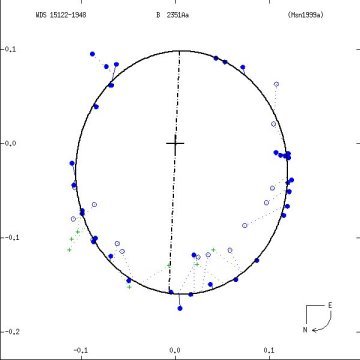
 |
Iota Librae Ab goes around Iota Aa (the brighter and more massive of the two, placed at the cross) every 23.5 years at an average separation of 14.9 Astronomical Units. The points are individual observations to which the best orbit is fitted. The dot-dash line is the orbit's major axis. Since the orbit is tilted by 26 degrees to the plane of the sky, it is somewhat distorted from the way it would look if seen face-on. The arrow at lower right shows the direction of motion. Though Aa is placed at the focus of the Ab's orbit, in truth, both stars go about each other, orbiting around a common center of mass, which is not determined for this pair. North is down, as would be seen in a telescope. The scales around the edges are in seconds of arc. Far off the page is another pair (Iota B and C) that orbits this one. (From an article by B. D. Mason, G. G. Douglass, and W. I. Hartkopf in the Astronomical Journal, vol. 117, p. 1023, 1999, image courtesy of W. I. Hartkopf.) |